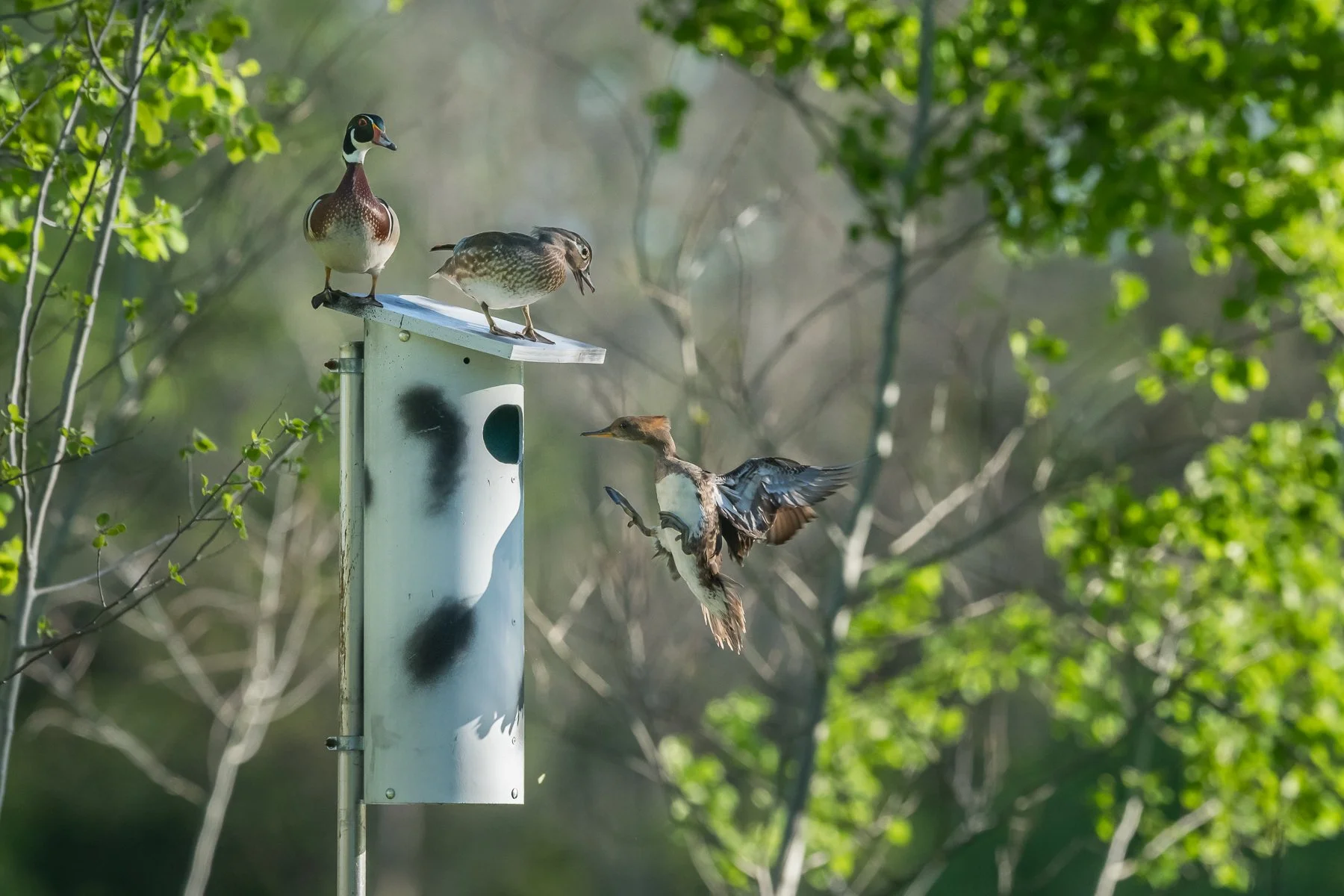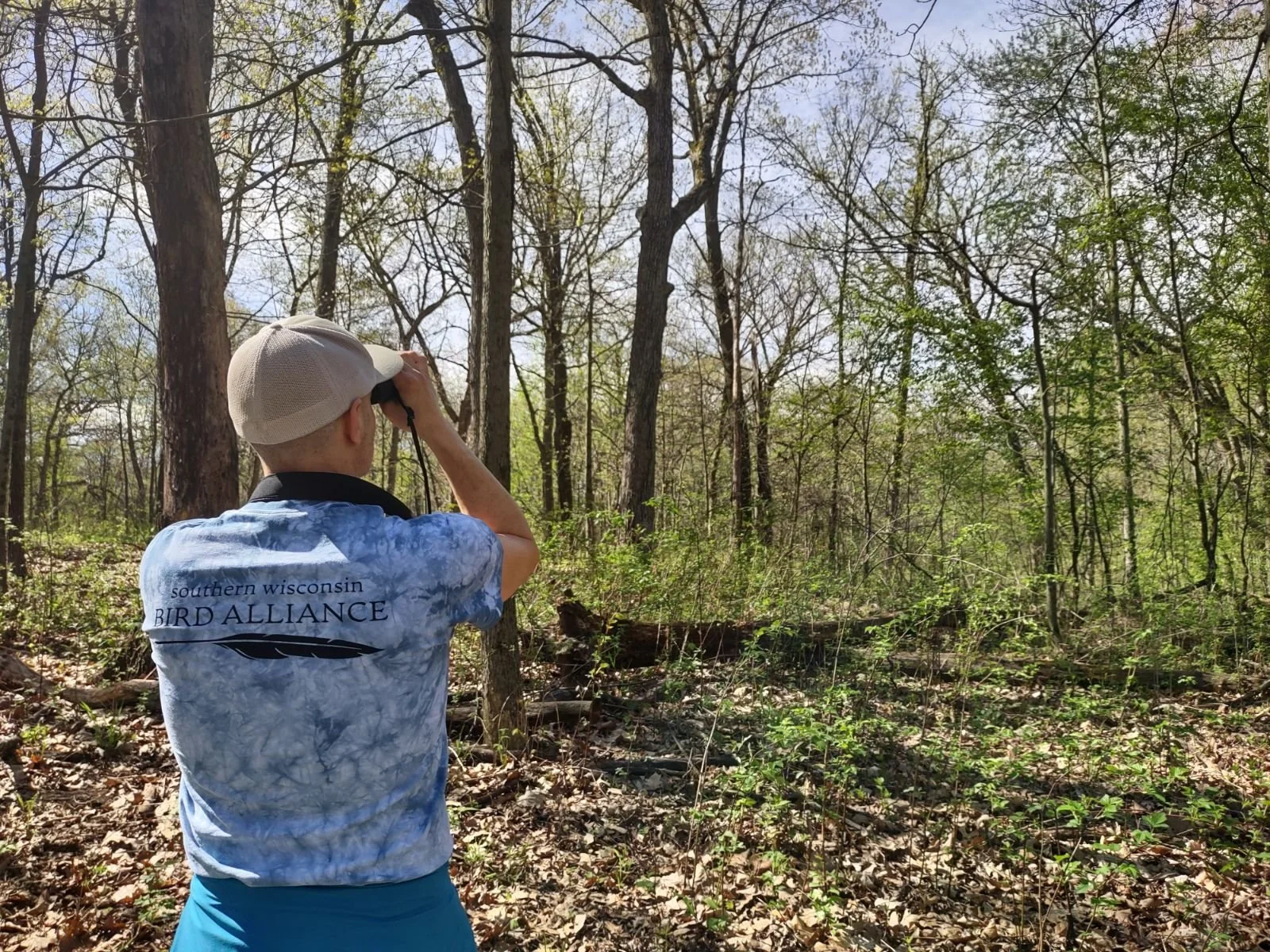Fair Meadows Sanctuary’s
Friday Feathered Features
This weekly blog series that focuses on a bird species, project, or event that is timely, interesting, and fun! The write-ups alternate between our sanctuary teams. Below are some of the most recent articles written by the team at Fair Meadows. You can enjoy all of Fair Meadows Sanctuary’s FFF posts here or read all Friday Feathered Features here.
Fair Meadows Sanctuary’s most recent features
The birds are slim and dark with black heads, necks, and breasts. Their wings are a light gray and sometimes you can catch a glimpse of white undertail coverts. Black Terns!
Photo by Gary Shackelford
When I looked up, there were now two birds in the sky—the hawk and a smaller bird. What I witnessed next was a once-in-a-lifetime experience.
Photo by Gary Shackelford
A flash of yellow and a chestnut necklace catch my eye and there it is—a tiny bird, actively moving along the tips of the foliage in the upper canopy.
Photo by Gary Shackelford
At Fair Meadows Sanctuary, one fact has been made abundantly clear: there is keen competition for nesting sites, both in artificial structures and in tree cavities.
Photo by Gary Shackelford
It’s one of those cool, misty mornings in late July. I am awakened at 5:30 by a sweet song in the nearby prairie—the paired notes of an Indigo Bunting.
Photo by Gary Shackelford
Typical of this small, fast-moving denizen of the treetops, our gnatcatcher led us to the spot where he and his mate were busy constructing their nest, a compact cup positioned on the top of a limb and resembling a tree knot.
Photo by Gary Shackelford
I’m slow-birding, watching for activity in my favorite bush—a large, spreading red-osier dogwood—when a bright yellow bird lands right in the middle. He moves along the branches, searching for food, and stops every few seconds to sing, “sweet sweet I’m so sweet.”
Photo by Gary Shackelford
As I reach the pond, I approach slowly, attempting to remain concealed behind some trees. And then I see it—the year’s first Solitary Sandpiper, feeding in the shallows.
Photo by Gary Shackelford
The telltale sign of a Tree Swallow nest is often feathers. In some cases, there are so many feathers, you can’t even see the underlying nest structure of dry grass or pine needles.
Photo by Gary Shackelford
Canada Geese are year-round residents at Fair Meadows Sanctuary, and they are excellent subjects for a slow birder.
Photo by Gary Shackelford
The birds undulate, appearing to ride a roller coaster as they fly. From the buoyant, dancing pattern, I know they must be American Goldfinches.
Photo by Gary Shackelford
The familiar Gadwall (Mareca strepera), a widespread dabbing duck, is a common spring and fall migrant in Wisconsin. Gadwalls are also occasional winter residents in the southeastern part of the state.
Photo by Gary Shackelford
Mourning Doves are one of our most common birds, with a US population estimated at 350 million. Indeed, if you were asked to design a bird that would thrive in the present day, you would come up with the features of a Mourning Dove.
Photo by Gary Shackelford
With a seemingly oversize head and bill, shaggy-crested head, short tail, white underparts, complete white collar across the hindneck, and overall blue-gray dorsum, the Belted Kingfisher is unmistakable.
Photo by Gary Shackelford
We first recorded Bald Eagles nesting at Fair Meadows in 2010, and it has been monitored as part of Southern Wisconsin Bird Alliance’s Bald Eagle Nest Watch program since 2019.
Photo by Gary Shackelford
Now more than two decades old, Mirror Pond is a well-established addition to the landscape, providing habitat for many species of animals.
Photo by Gary Shackelford
A localized patch of giant ragweed was bouncing as a family of Rose-breasted Grosbeaks hopped from branch to branch using their huge beaks to grasp and remove the seed centers of dried blossoms.
Photo by Gary Shackelford
Cedar Waxwings are named for the bright red, waxlike tips on the secondary flight feathers of adult birds. For unknown reasons, the number of these tips varies.
Photo by Gary Shackelford
Sometime during the first week of May, witch-ity witch-ity witch-ity announces the arrival of the Common Yellowthroats at Fair Meadows.
Photo by Gary Shackelford
Several years ago, a pair of American Kestrels occupied a nest box in one of the prairies at Fair Meadows, and I had the opportunity to observe social interactions of their newly fledged young.
Photo by Gary Shackelford
Yellow-crowned Night Herons are spotted regularly during migration in southern Wisconsin, and may even breed rarely in the state, with a few reports in the Wisconsin Breeding Bird Atlas.
Photo by Andy Reago & Chrissy McClarren.
Wild Turkeys are common year-round residents at Fair Meadows. Breeding season begins in March, but most active courtship occurs in April and May.
Photo by Gary Shackelford
I’m enjoying my morning coffee when suddenly, there’s the arrival of a large, bright rufous bird with an impressive down-curved beak, long tail, and emphatic spots (streaks) on the breast—a Brown Thrasher!
Photo by Kelly Colgan Azar
The Great Wisconsin Birdathon is run by the Natural Resources Foundation of Wisconsin to raise funds for bird conservation across the state. Southern Wisconsin Bird Alliance’s team, the Flockadelics, participated on May 1.
Photo by Carolyn Byers/SoWBA
Many bird watchers look forward to the annual crane count coordinated by the International Crane Foundation. This year, it was held on April 13.
Photo by Gary Shackelford
This prairie version of a suburban rain garden or a woodland vernal pool is a valuable food resource for both migrating and resident birds.
Photo by Gary Shackelford
Vociferous by nature and by scientific name (Charadrius vociferus) the Killdeer gets its common name from the sound of its shrill, far-carrying cry as it circles in flight.
Photo by Gary Shackelford
Leucism is a condition caused by a genetic mutation that results in the loss of all types of pigmentation—the affected areas can be either entirely white or a pale, washed out shade of the expected coloration.
Photo by Gary Shackelford
For the past ten years, our first sight and sound of Sandhill Cranes at Fair Meadows has been a gentle unison call and the graceful glide of a pair descending into the sedge meadow south of our house.
Photo by Gary Shackelford
Banner photo: Fair Meadows prairie in bloom by Gary Shackelford


































Careful study of the Mallard and American Black Duck has allowed me to reliably distinguish them from one another when I get good, clear views of plumage and bill color.
Photo by Gary Shackelford